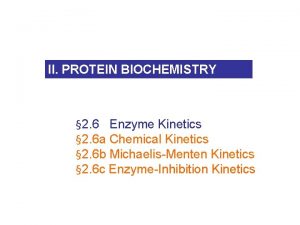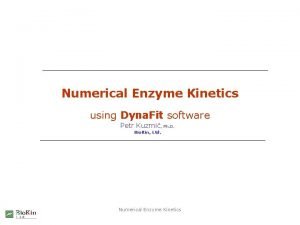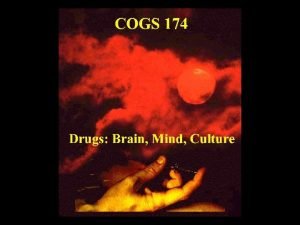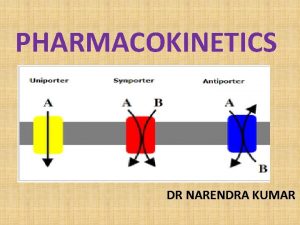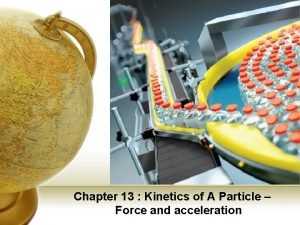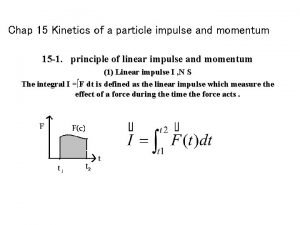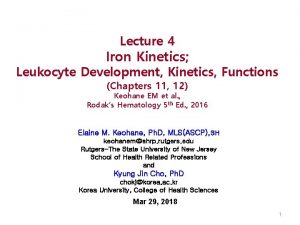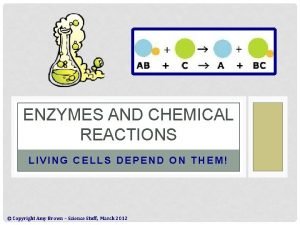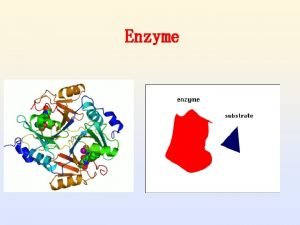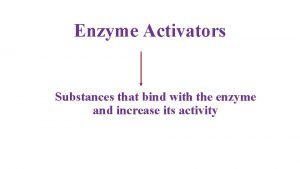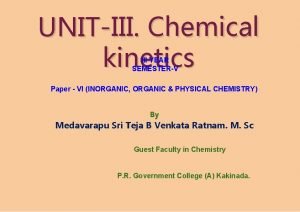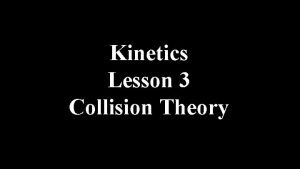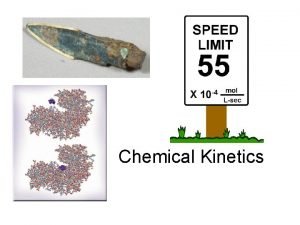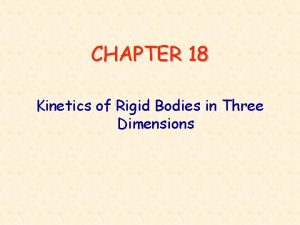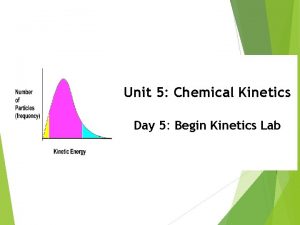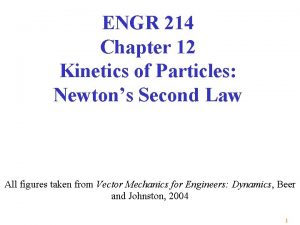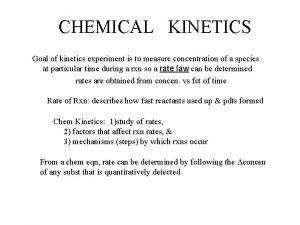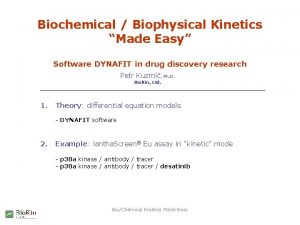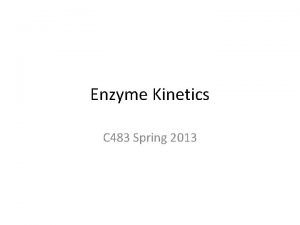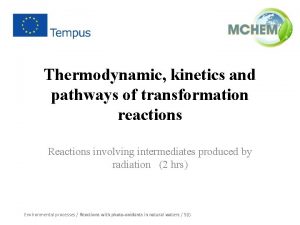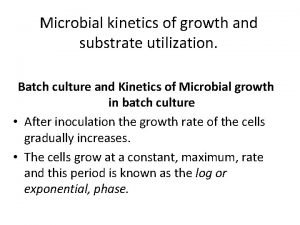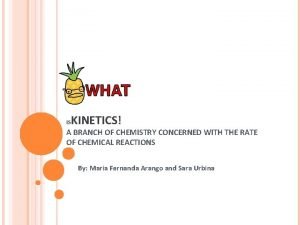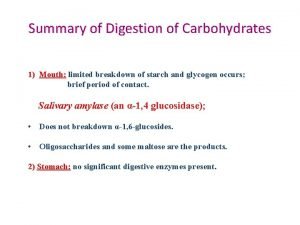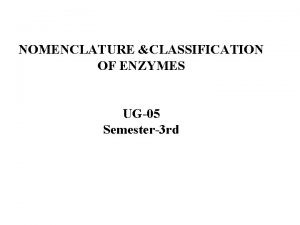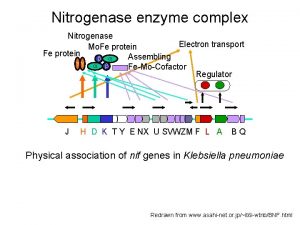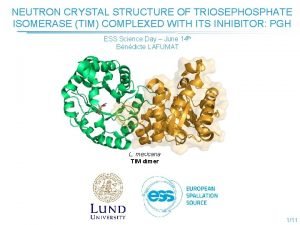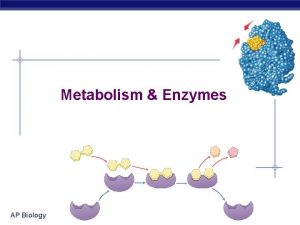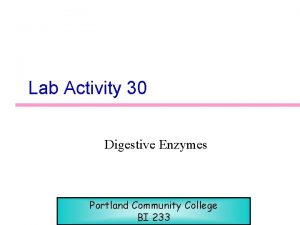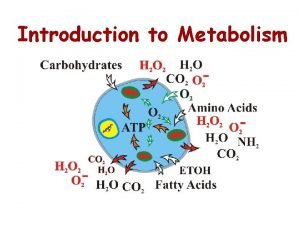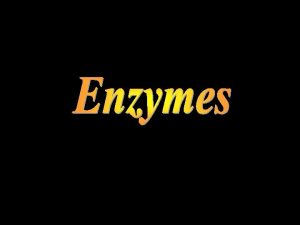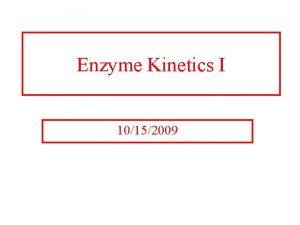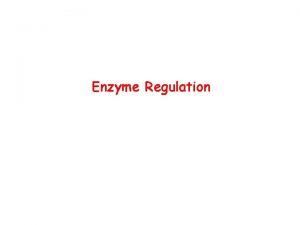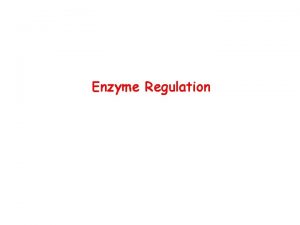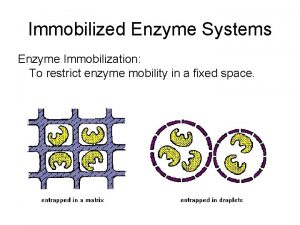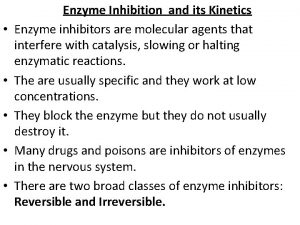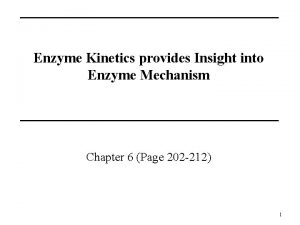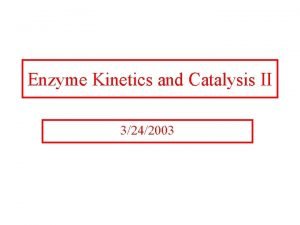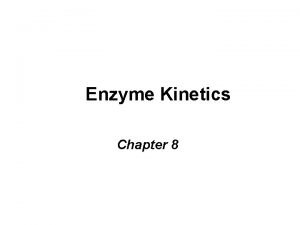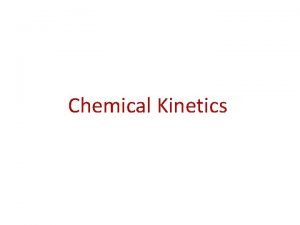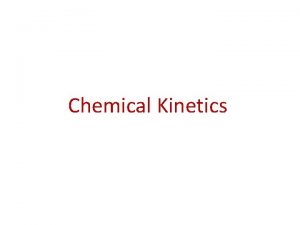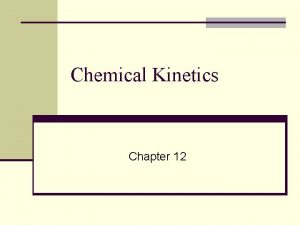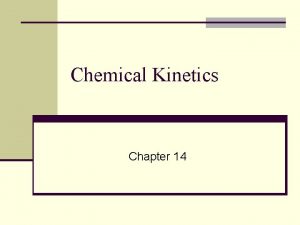Process Kinetics Important Process and their Kinetics Enzyme

























![Tessier equation: μ = μm [1 - exp(-KCS)] μm = 0. 9 per h Tessier equation: μ = μm [1 - exp(-KCS)] μm = 0. 9 per h](https://slidetodoc.com/presentation_image_h2/10d578da04e7b731c544bf13ea8f2353/image-26.jpg)































- Slides: 57

Process Kinetics

Important Process and their Kinetics • Enzyme kinetics • Fermentation kinetics

Microbial Cell Growth Microbial growth implies an increase in cellular constituents - leads to rise in cell number when microorganisms reproduce by processes like budding or binary fission - ability to reproduce is a major criterion to determine if a microbe is alive or not - results when cell become longer/larger Population growth is used to analyze the growth curve of a microbial culture

Microbial Cell Growth • Mode of Growth • Selective assimilation of nutrients and convert into and also include Chemical rearrangement of protoplasmic material characteristic of the particular organism • Production of an increased amount of nuclear substance and cell division

Microbial growth summary • Energy + nutrient biomass and products • Energy (light or chemical): phototrophs and chemotrophs • Nutrient (carbon source): autotroph and heterotroph

Stoichiometry of growth • Carbon + Nitrogen + (P&vitamins&minerals) + O 2 biomass + CO 2 + H 2 O + products + heat • CHl. Om + βNH 3 + O 2 CHa. Ob. Nc + CHp. Oq. Nr + H 2 O + CO 2 CHl. Om : element composition of the carbon sources CHa. Ob. Nc: element composition of biological materials CHp. Oq. Nr element composition of extracellular products (All defined as containing 1 gram atom of carbon)

Atomic balance • CHl. Om + βNH 3 + O 2 CHa. Ob. Nc + CHp. Oq. Nr + H 2 O + CO 2 C: =1+ + H: l + 3β = a +1+ p + 2 O: m + 2 = b + β + q + + 2 N: β = c + r

Respiratory coefficient and degree of reductance • Respiratory quotient or coefficient (RQ) • RQ = rate of CO 2 production/rate of O 2 consumption • Degree of reductance ( ): the number of equivalents of available electrons per gram atom of C. • C: 4, . H: 1, O: -2, N: -3: P: 5 • H 2 O, CO 2, NH 3=0, glucose = 24.

Cell Growth and Binary Fission Fts proteins Min E proteins assist in the location of the actual cell midpoint forms in the space between the duplicated nucleoids


The Fts. Z ring and cell division forms a ring around the cylinder in the center of the cell

2 copies of chromosomes are pulled apart to each daughter cell



Microbial Growth Kinetics - describe how the microbe grows in the fermenter - important to determine optimal batch times - growth of microbes can be broken down into 4 stages; accelerated death phase LAG PHASE LOG/EXPONENTIAL PHASE STATIONARY PHASE DEATH PHASE decelerated growth phase Lag Phase accelerated growth phase Cells have just been introduced into a new environment Cell growth is minimal Cell is synthesizing new components – no cell division takes place - cell is old and depleted of ATP - medium may be different from the one the microorganism was growing - microorganism have been injured and require time to recover

LOG/EXPONENTIAL PHASE Cells have adjusted to their environment Rapid growth takes place Cell growth rate is highest in this phase At some point, cells growth rate level off and become constant STATIONARY PHASE Cell growth rate has leveled off and become constant Number of cells multiplying equals the number of cells dying - nutrient limitation - aerobic organism are limited by oxygen availability - population growth cease due to the accumulation of toxic waste products DEATH PHASE Decline in the number of viable cells

Log/Exponential Phase The rate of increase in biomass is correlated with the specific Growth rate µ and the biomass concentration X (g/L), whereas the Rate of sincrease in cell number is correlated with µ and cell density N (1/L) d. X = µ • X dt or d. N = µ • N dt specific growth rate, µ, 3 parameters : the concentration of limiting substrate S the maximum growth rate µmv the substrate-specific constant Ks µ = µm ___S___ Ks + S Monod equation Ks substrate concentration at which half the maximum specific growth rate is obtained (µ = 0. 5 µm ) - equivalent to the Michaelis constant in enzyme kinetics

Growth Approximation

Approaches to modeling cell growth: Unstructured Models Structured Models (cell population is treated as single component) (cell population is treated as a multicomponent system) Nonsegregated Models Segregated Models (cells are treated as homogeneous) (cells are treated heterogeneous)

Approaches to modeling cell growth: Unstructured Nonsegregated Models Structured Segregated Models (cell population is treated as single component, and cells are treated as homogeneous) (cell population is treated as a multicomponent system, and cells are treated heterogeneous) Simple and applicable to many situations. Most realistic, but are computationally complex.

Unstructured, nonsegregated models: Monod model: μ= μm C S Most commonly used model for cell growth KS + C S μ : specific (cell) growth rate μm : maximum specific growth rate at saturating substrate CS : substrate concentration KS : saturation constant (CS = KS when μ = μm / 2) concentrations

Unstructured, nonsegregated models: Monod model: μ= Most commonly used model for cell growth μm C S KS + C S μm = 0. 9 per h Ks = 0. 7 g/L

Assumptions behind Monod model: - One limiting substrate - Semi-empirical relationship - Single enzyme system with M-M kinetics being responsible for the uptake of substrate - Amount of enzyme is sufficiently low to be growth limiting - Cell growth is slow - Cell population density is low

Other unstructured, nonsegregated models (assuming one limiting substrate): Blackman equation: μ = μm if CS ≥ 2 KS μ = μm C S 2 KS Tessier equation: Moser equation: μ = μm [1 - exp(-KCS)] μ = μm C S n KS + C S n Contois equation: μ = μm C S KSX CX + CS if CS < 2 KS

Blackman equation: μ = μm μ= if CS ≥ 2 KS μm C S 2 KS This often fits the data better than the Monod model, but the discontinuity can be a problem. if CS < 2 KS μm = 0. 9 per h Ks = 0. 7 g/L
![Tessier equation μ μm 1 expKCS μm 0 9 per h Tessier equation: μ = μm [1 - exp(-KCS)] μm = 0. 9 per h](https://slidetodoc.com/presentation_image_h2/10d578da04e7b731c544bf13ea8f2353/image-26.jpg)
Tessier equation: μ = μm [1 - exp(-KCS)] μm = 0. 9 per h K = 0. 7 g/L

Moser equation: μ = μm C S n When n = 1, Moser equation describes Monod model. KS + C S n μm = 0. 9 per h Ks = 0. 7 g/L

Contois equation: μ = μm C S KSX CX + CS Saturation constant (KSX CX ) is proportional to cell concentration

Extended Monod model: KS + CS – CS, min μ (per h) μ= μm (CS – CS, min) Extended Monod model includes a CS, min term, which denotes the minimal substrate concentration needed for cell growth. μm = 0. 9 per h Ks = 0. 7 g/L CS, min = 0. 5 g/L

Monod model for two limiting substrates: μ= μm CS 1 CS 2 KS 1 + CS 1 KS 2 + CS 2

Monod model modified for rapidly-growing, dense cultures: Monod model is not suitable for rapidly-growing, dense cultures. The following models are best suited for such situations: μ= μm C S KS 0 CS 0 + CS μ= μm C S KS 1 + KS 0 CS 0 + CS where CS 0 is the initial substrate concentration and KS 0 is dimensionless.

Monod model modified for substrate inhibition: μ (per h) Monod model does not model substrate inhibition. Substrate inhibition means increasing substrate concentration beyond certain value reduces the cell growth rate.

Monod model modified for cell growth with noncompetitive substrate inhibition: μm μ= (1 + KS/CS)(1 + CS/KI ) μm C S = KS + CS 2/KI + KS CS/KI If KI >> KS then μ= μm C S KS + CS 2/KI where KI is the substrate inhibition constant.

Monod model modified for cell growth with competitive substrate inhibition: μ= μm C S KS(1 + CS/KI) + CS where KI is the substrate inhibition constant.

Monod model modified for cell growth with product inhibition: Monod model does not model product inhibition (where increasing product concentration beyond certain value reduces the cell growth rate) For competitive product inhibition: μ= μm C S KS(1 + Cp/Kp) + CS For non-competitive product inhibition: μ= μm (1 + KS/CS)(1 + Cp/Kp ) where Cp is the product concentration and Kp is a product inhibition constant.

Monod model modified for cell growth with product inhibition: Ethanol fermentation from glucose by yeasts is an example of non-competitive product inhibition. Ethanol is an inhibitor at concentrations above nearly 5% (v/v). Rate expressions specifically for ethanol inhibition are the following: μ= μm C S (KS + CS) μ= μm C S (1 + Cp/Cpm) exp(-Cp/Kp) (KS + CS) where Cpm is the product concentration at which growth stops.

Monod model modified for cell growth with toxic compound inhibition: For competitive toxic compound inhibition: μ= μm C S KS(1 + CI/KI) + CS For non-competitive toxic compound inhibition: μ= μm (1 + KS/CS)(1 + CI/KI ) where CI is the product concentration and KI is a constant to be determined.

Monod model extended to include cell death kinetics: μ= μm C S KS + C S where kd is the specific death rate (per time). - kd

Limitations of unstructured non-segregated models: • No attempt to utilize or recognize knowledge about cellular metabolism and regulation • Show no lag phase • Give no insight to the variables that influence growth • Assume a black box • Assume dynamic response of a cell is dominated by an internal process with a time delay on the order of the response time • Most processes are assumed to be too fast or too slow to influence the observed response.

Product formation kinetics • Classified based on the relationship between product synthesis and energy generation in the cell – Growth associated – Non-growth associated – Mixed-growth associated

Products • Growth-associated § produced at the same time as cell growth – constitutive enzymes (ones that are normally present) • glucose isomerase – metabolic intermediates • pyruvate, citrate, acetate • Non-growth-associated § takes place during the stationary phase (m=0) – secondary metabolites • antibiotics • Mixed - growth associated § takes place during growth and stationary phases – metabolic byproducts • lactate, ethanol – secondary metabolites

Product generation X, P Time Growth-associated X, P Time Mixed-growth associated Non-growth associated

Product Formation • Growth-associated products - produced simultaneously to growth (exponential, decline) Constitutive Expressed Enzyme § Substrate Utilization enzymes § • Non growth associated - takes place during stationary phase qp= constant Antibiotics § RDX degradation §

Product Formation - cont • Mixed-growth-associated • Luedeking-Piret Equation § = 0 non-growth associated § b = 0 only growth associated § = YP/X • Examples § Lactic acid fermentation § Xanthan gum production

Microbial Growth Maintenance Coefficient 1 mole of ATP generated during catabolism allows • theoretically → synthesis of 32 g cells • in praxis → 10. 5 g cells The maintenance coefficient (ms) is the reason for 2/3 being “wasted” 1. Substrate transport into cell (e. g. against diffusion gradient) 2. Osmotic work 3. Motility 4. Intracellular p. H 5. Replacement of thermally denatured proteins (↑ T → ↑ ms) 6. Leakage of H+ ions across membrane (uncoupling) S (mg) ms = X (mg) • time (h) ms influences Y, μ and the metabolic activity of the cells and is thus important to be considered in bioprocesses.

Effect of Maintenance Coefficient on Growth Rate What is maintenance coefficient? The energy supply rate needed to maintain the life functions of a non growing cell. Units? strictly speaking: mol ATP/ cell/ h mostly used: g substrate / g biomass / h = (h-1)

Effect of Maintenance Coefficient on Growth Rate What does the maintenance coefficient (m. S) affect? • ms is the reason for Y not being constant. á ms �Y hence á ms �u Why? Because some substrate is taken up just for maintenance, not for growth. • Effect is more apparent in slow growing cultures than in fast growing cultures. • Slow growing cultures can have a very low Y. m. S (g. S/g. X/h) * Ymax (g. X/g. S) = Decay rate (h-1)

Effect of maintenance coefficient on growth rate Effect of m. S on Y? Y is the observed yield coefficient. The maximum yield coefficient Ymax is approached only when m = mmax Ymax is one of four growth constants

Effect of maintenance coefficient on growth rate m. S and Ymax can be combined: m. S (g. S/g. X/h) * Ymax (g. X/g. S) = Decay rate (h-1) The Pirt equation of growth includes all four growth constants: S µ = µmax * ---- - m. S *Ymax S + k. S

Effect of maintenance coefficient on growth rate ms the respiration u = (v – m. S) *Ymax S u = ( vmax * ---- - m. S) * Ymax S + k. S S µ = Ymax * vmax * ---- - m. S *Ymax S + k. S S µ = µmax * ---- m. S *Ymax S + k. S substrate uptake activity used to just stay alive

Effect of Maintenance Coefficient (m. S) on growth Rate ignoring m. S S µ = µmax * -----S + k. S µ (h-1) 0 S(g/L) including m. S S µ = µmax * ---- - m. S *Ymax S + k. S And 5151

Effect of Maintenance Coefficient (m. S) on growth Rate Sm = critical substrate concentration growth is zero µ (h-1) m. S. k. S. Ymax sm= ---------umax- ms. Ymax 0 S(g/L) Sm

Effect of Maintenance Coefficient (m. S) on growth Rate The negative specific growth rate (µ) observed in the absence of substrate (when S = 0) (cells are starving, causing loss of biomass over time) µ (h-1) 0 S(g/L) - m. S*Ymax is the decay rate m. S*Ymax

Light Illumination Effect • Oscillatoria agardhi Gomont § (Post AF, R de Witt, LC Mur, J. Plank. Res. , 7 (1985) 487 -495)

Temperature effect • Modified Arhenius Model

Temperature Effect Classification of Microorganism

• Questions?
 Mixed inhibitor km and vmax
Mixed inhibitor km and vmax Exercise 2
Exercise 2 Enzyme kinetics
Enzyme kinetics Example of a news story
Example of a news story Inverted pyramid in news writing
Inverted pyramid in news writing Least important to most important
Least important to most important Kinetics and equilibrium
Kinetics and equilibrium Difference between 1st order and zero order kinetics
Difference between 1st order and zero order kinetics Difference between 1st order and zero order kinetics
Difference between 1st order and zero order kinetics Planar kinetics of a rigid body force and acceleration
Planar kinetics of a rigid body force and acceleration Kinetics of a particle force and acceleration
Kinetics of a particle force and acceleration Kinetics of a particle: impulse and momentum
Kinetics of a particle: impulse and momentum Rodak
Rodak Kinematics and kinetics of rigid bodies
Kinematics and kinetics of rigid bodies Planar kinetics of a rigid body work and energy
Planar kinetics of a rigid body work and energy Cell kinetics and fermenter design
Cell kinetics and fermenter design Enzyme catalyzed reaction
Enzyme catalyzed reaction Enzyme activation
Enzyme activation Enzyme activators and inhibitors
Enzyme activators and inhibitors Romeo and juliet act 2 prologue translation
Romeo and juliet act 2 prologue translation Molecularity of reaction
Molecularity of reaction Zero order elimination drugs
Zero order elimination drugs Fbd and kd
Fbd and kd Collision theory of kinetics
Collision theory of kinetics Types of reactions grade 11
Types of reactions grade 11 Kinetics flotation reagents
Kinetics flotation reagents Order kinetics
Order kinetics Chemical kinetics definition
Chemical kinetics definition Kinetics of rigid bodies
Kinetics of rigid bodies Ap chem kinetics
Ap chem kinetics Kinetics of crystal violet fading
Kinetics of crystal violet fading Octet biosensors
Octet biosensors Kinetics of particles newton's second law
Kinetics of particles newton's second law Chemical kinetics experiment
Chemical kinetics experiment Dynafit kinetics
Dynafit kinetics Data kinetics ltd
Data kinetics ltd Kcat
Kcat Kinetics reaction
Kinetics reaction Applications of chemical kinetics
Applications of chemical kinetics Growth kinetics
Growth kinetics Define steady state approximation
Define steady state approximation Kinetics is the branch of:
Kinetics is the branch of: Vampnets for deep learning of molecular kinetics
Vampnets for deep learning of molecular kinetics Hyaluronidase enzyme
Hyaluronidase enzyme Gilbert syndrome lab values
Gilbert syndrome lab values Digestion of carbohydrates
Digestion of carbohydrates Enzyme purification
Enzyme purification Drug metabolism definition
Drug metabolism definition Define drug metabolism
Define drug metabolism Nitrogenase enzyme complex
Nitrogenase enzyme complex Enzyme cooperativity
Enzyme cooperativity Enzyme ec number
Enzyme ec number Nitrogenase enzyme complex
Nitrogenase enzyme complex Keplas
Keplas Enzyme ap bio
Enzyme ap bio Brush border enzyme
Brush border enzyme Enzyme cooperativity
Enzyme cooperativity Enzyme classes
Enzyme classes

